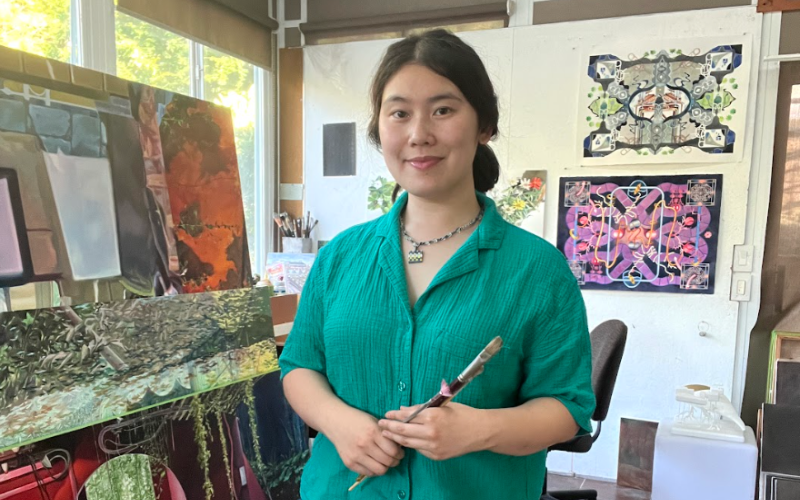
Based in Los Angeles, Featured Artist Karen Kuo creates painted geometric configurations and quilted ceramic sculptures that use pattern as a tool for emotional and intuitive expression.
Her compositions are layered and labyrinthine, shaped by recurring visual motifs (spheres, light rays, towers, and bars) all tied to personal significance. These forms show up across her work like familiar markers, creating a visual rhythm that ties everything together.
Working across a range of visual vocabulary—from hyperrealist to perceptual to fully abstract—Kuo's work is best understood when viewed altogether, whereby a unifying language describing physical and spiritual life emerges.
Artwork Archive had the chance to chat with Karen Kuo about about her creative process, how she finds her way back after feeling disconnected, and why she didn’t wait to get organized with Artwork Archive.
You can see more of her work on Discovery and learn more about her art practice below:
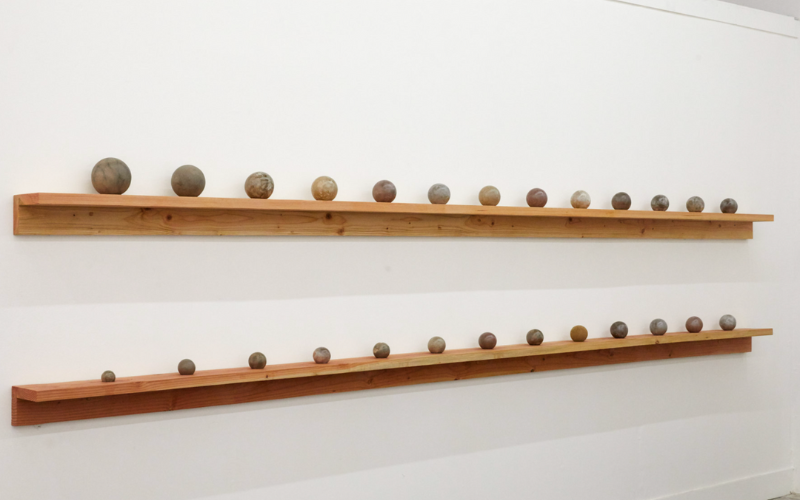
Karen Kuo, Dorodangos, 2024
How Her Work Comes to Life
For artist Karen Kuo, every piece begins in a sketchbook. Whether the finished work ends up as a sculpture or a painting, drawing is always the first move she makes. She sees it as a kind of raw intake valve, where ideas are captured in their earliest, most unfiltered form. “It’s the most intuitive and unfiltered way for me to capture ideas while they’re still fresh."
She gives the early stage her full attention, often doing the bulk of the logistical work up front. “I tend to front-load the labor and planning,” she notes, so that she can move more fluidly once she begins building the piece. It helps her find a rhythm, one that hinges on two very different moments: “My favorite part of the process is the ideation phase—when everything feels open and full of possibility—and, of course, arriving at some form of resolution in the work.”
Why the Work Chooses the Style, Not the Other Way Around
Each new body of work starts with something Kuo is curious about. She gives it space to grow, to shift, to repeat itself with variation. “I follow a question through a series until it runs its course, then often return to it from a new angle."
To stay open and flexible, she works in different modes. Some days are for plein air studies—a way to slow down and pay attention. Others are for fast, intuitive paintings that get finished in a single sitting. Both types of work sharpen her instincts. “That immediacy teaches me to make decisions and resolve things in a different way.”
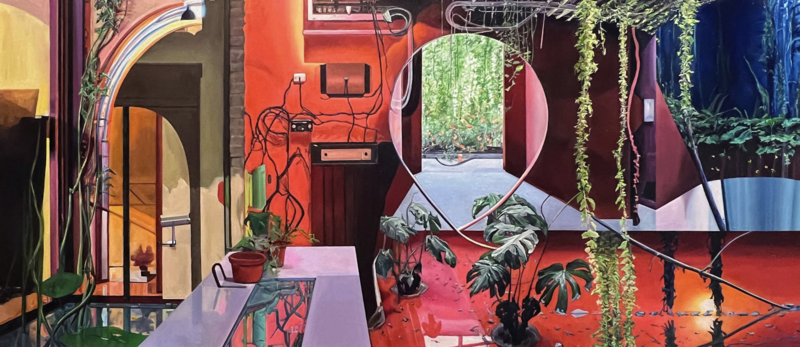
Karen Kuo, Standing Poolside, 32 x 75 x 1.5 in
A Language of Symbols That Keep Showing Up
Karen Kuo's recurring motifs have become part of how she sees the world. Over time, certain images have carved out a place in her visual vocabulary, returning again and again with new context. Two stand out most clearly: the sphere and the light ray.
The sphere speaks to something steady and expansive. “It feels universal; it shows up at every scale—from planets to cells—and carries this quiet sense of continuity,” she describes. The light ray enters with more urgency. It carries energy, even disruption. “The light ray, on the other hand, suggests a kind of rupture or revelation, like something breaking through.” Its presence often signals a shift, an opening, a moment when something hidden comes into view.
Both symbols suggest larger systems at play: movements and patterns that feel persistent, ancient, and interconnected. “I think I’m drawn to both because they point to forces larger than us, patterns that feel enduring across time and space.”
When Stepping Away Brings You Back
This artist knows what it feels like to hit a wall in her practice. But instead of treating those moments as problems to be fixed, she sees them as signs that she needs to realign, first with herself, then with the work. “If I’m feeling disconnected from my work, it usually means I’m disconnected from myself,” she reflects.
It’s rarely about the work itself. More often, it’s a sign she hasn’t moved enough, slept enough, or nourished herself in the ways she needs to. Instead of doubling down in the studio, she’s learned to shift her focus. “I try to reconnect through joy—spending time with people I love, getting outside, playing with my dog.” From that place, work starts to feel approachable again, and her clarity returns.
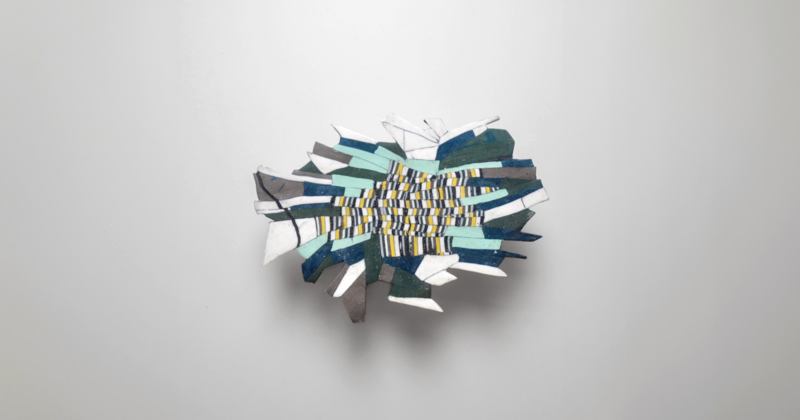
Karen Kuo, Aperture, 2023, 8 x 12 x 0.25 in
Letting Curiosity Lead
Rather than trying to force progress or chase external validation, Karen Kuo focuses on the questions that naturally arise through making. “If you stay close to what you’re genuinely curious about and keep folding new questions and ideas into the work, momentum builds naturally."
As her work evolves, she pays attention to what feels alive in the studio. Over time, this mindset has helped her recognize the rhythms that feel most true to her—what energizes her, what challenges her, and what sustains her.
Sharing her work publicly has also helped her see which parts connect with others, and which don't. But Kuo doesn’t take every opinion to heart. She’s learned to trust her instincts, to hold space for her own voice even when others are speaking. That self-trust, she’s found, is just as much a part of the process as the making itself.
Finding the Language to Share Her Work
One of the hardest parts of being an artist, Kuo admits, has been learning how to talk about the work. “Early on, I thought the work would speak for itself, but that’s rarely the case.”
So she began practicing a new kind of skill, one rooted in communication. She thought about what it mean to offer someone access, to create a bridge between her internal world and theirs. "You're living inside a world of your own making, but how do you bring someone in?"
That question has guided her ever since. “Finding clearer language has helped me share the work with more care and intention.” It hasn’t required her to explain everything. Instead, it’s helped her shape a more intentional invitation to connect with others in meaningful ways.
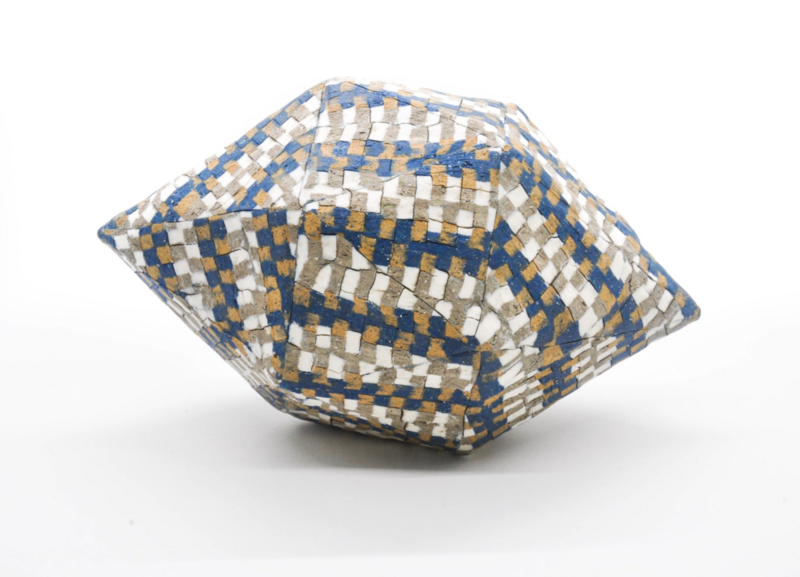
Karen Kuo, Checker Woven Gem, 2021, 5 x 8.5 x 5 in
A Head Start on Organization
Karen Kuo chose to set up an archiving system early in her career. Right after earning her BFA, she began using Artwork Archive to manage her growing body of work. Her decision was shaped by what she saw while working with artists who were sorting through decades of undocumented pieces. “I’d worked with older artists who were trying to backtrack and document decades of work, and I wanted to avoid that scramble by starting early,” she explains.
She looked for a platform that felt approachable, and Artwork Archive's interface caught her attention right away. “You can see all the key details of a piece just by hovering over the image,” she says.
It felt intuitive and simple to learn. More importantly, it helped her stay ready when opportunities came up, allowing her to share her work in a polished, organized way.
Make the Most of the Details Field:
When you’re entering a new piece, take an extra minute to fill in the description or notes section—even if it’s just a short line about what you were thinking, where it was made, or what sparked the idea.
A few months (or years) from now, those breadcrumbs will be valuable to you and to anyone writing about or showing your work.
Making the Viewer Experience Part of the Practice
For Kuo, the way art is shared matters just as much as how it’s made. That’s why two tools in Artwork Archive quickly became essential to her: Private Rooms and Collections.
These features let her sort and group work by medium, series, or project type, then customize who sees what. When she sends work to curators or collaborators, it’s a curated experience that reflects how she wants the work to be felt. “That’s actually what convinced me to sign up,” she remembers. “I care a lot about making the experience of seeing my work feel smooth and intentional.”
These are the tools that help her create that feeling. Instead of overwhelming someone with every piece she’s ever made, she can offer a focused view that shows the story, the range, or the rhythm of a specific body of work.
Guide the Viewer Like You Would In a Studio Visit:
Think of a Private Room like a digital studio walkthrough.
You get to choose the order someone sees the work, what details show up alongside it, and which pieces are in conversation. Add notes or context where it helps—especially if you won’t be there to talk them through it in person.
A view of a Private Room Featured Artist Karen Kuo made with Artwork Archive
Start Before It Feels Urgent
Karen Kuo has seen how much smoother a practice runs when the behind-the-scenes systems are already in place. For artists stepping into their careers, she offers this practical starting point: photograph your work as you go, and take the time each year to update your records.
That consistency can make a big difference. It gives you a clear view of your progress and helps you stay prepared when opportunities come your way.
Beyond the logistics, she also encourages artists to be students of the field. “Study as much art as you can to sharpen your sense of what matters and where your voice fits,” she says. Paying attention to what draws you in can help you better understand what you’re trying to say.
And when doubts creep in, Kuo sees that as a signal—not a setback. “If you can see where something’s missing, you can also seek out what will move the work forward.” That mindset has kept her grounded through the ups and downs of creative growth.
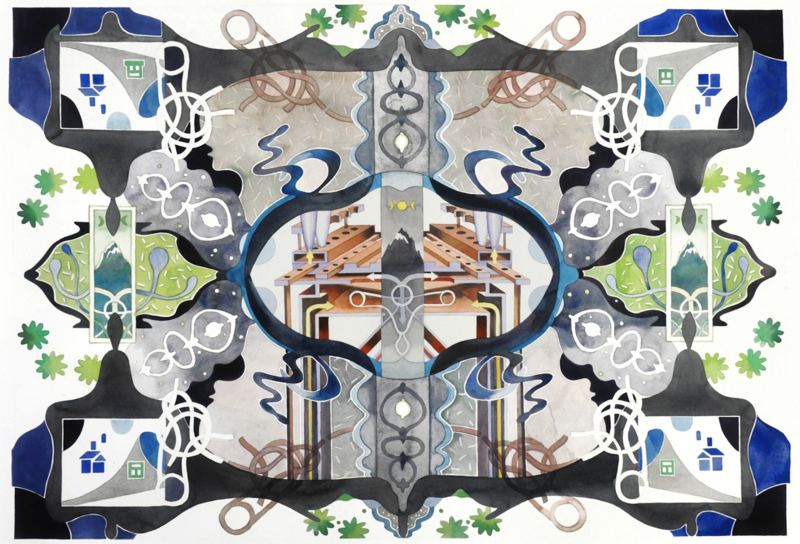
Karen Kuo, Organ Tunes, 2022, 22 x 30 in
No matter where you are in your art journey, getting your business side in order doesn’t have to feel overwhelming. A bit of structure now can mean more time and headspace for the work you actually want to be doing.
Artwork Archive helps artists build an online portfolio, stay on top of their inventory, and create things like tear sheets and invoices in just a few clicks. Start a free trial and see how it fits into your own process.





